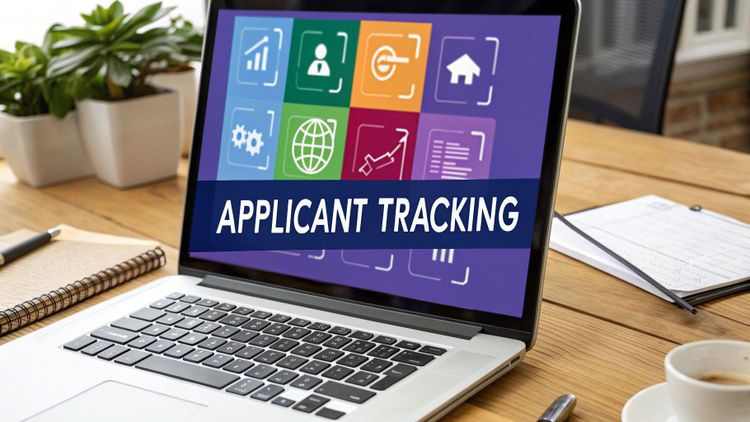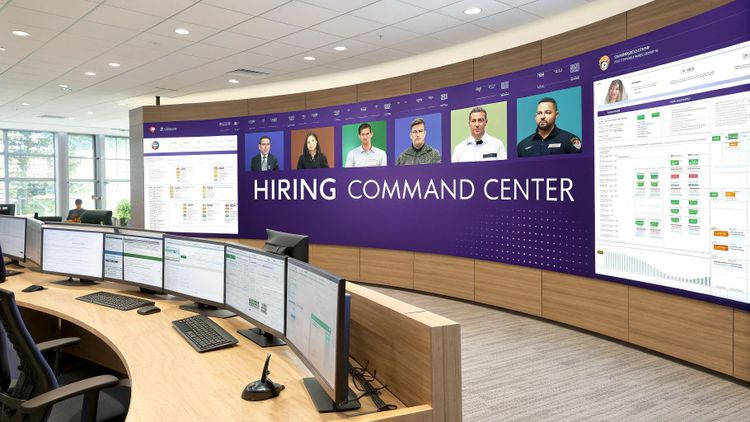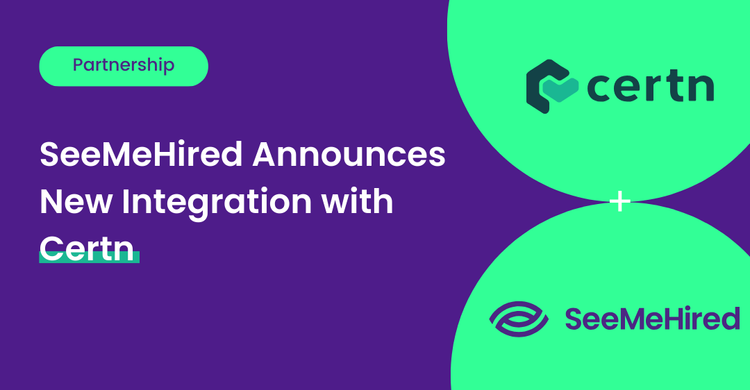HR Tech
A Guide to Small Business Applicant Tracking Systems

A Guide to Small Business Applicant Tracking Systems
Consider your current recruitment process. Is it a tangled web of spreadsheets, a flood of emails, and sticky notes covered with scribbled feedback? If that rings true, you're not alone. However, there is a much more efficient way to operate.
Listen to the Podcast Here:
A small business applicant tracking system (ATS) is a specialised software designed to bring organisation to this chaos. It serves as a central hub for all your recruitment activities, transforming cluttered inboxes and confusing spreadsheets into a single, organised system for every candidate and vacancy.
What Is a Small Business Applicant Tracking System?

Imagine attempting to find a specific book in a vast library without a cataloguing system. You'd likely spend hours searching. That's what manual hiring feels like. An ATS is that digital catalogue, enabling you to locate the right candidate information quickly. It’s a platform designed to manage job postings, track applicants through your recruitment stages, and even automate communications.
Previously, this kind of technology was viewed as a luxury, accessible only to large corporations with extensive HR departments. This is no longer the case. Today, a small business applicant tracking system is an affordable and essential tool for companies eager to compete for top talent. It levels the playing field.
From Manual Chaos to Organised Control
Without an ATS, a single hiring round can quickly become an administrative nightmare. CVs get lost in email threads, important feedback is scattered across multiple chats, and tracking who needs a response becomes a full-time job. This is not only inefficient but also creates a poor, unprofessional experience for potential employees.
An ATS simplifies the process by providing a single, reliable source for everything. Every application, CV, note, and message is stored in one accessible location. This change offers significant benefits:
No More Lost Candidates: Every applicant is automatically captured and organised. No one is overlooked.
Complete Visibility: Instantly see where each candidate is in your pipeline, from "Applied" to "Interview" to "Offer."
Consistent Communication: Set up automated emails to acknowledge applications or inform unsuccessful candidates, preserving your employer brand.
Seamless Team Collaboration: Your hiring team can share notes and feedback directly within the system, facilitating quicker, more cohesive decision-making.
To truly appreciate the difference, let's compare manual hiring with ATS-powered hiring.
Manual Hiring vs ATS-Powered Hiring at a Glance
This table highlights how everyday recruitment tasks transform when you shift from outdated manual methods to a modern ATS. The difference is clear, showing a move from time-consuming, error-prone work to efficient, organised processes.
| Hiring Task | Manual Method (Old Way) | With an ATS (Smart Way) |
|---|---|---|
| Posting a Job | Manually post on each job board individually. | Post to multiple job boards in one click. |
| Screening CVs | Sift through numerous emails and attachments. | CVs are parsed and searchable in one database. |
| Tracking Candidates | Complex spreadsheets and endless notes. | A visual pipeline shows each candidate's stage instantly. |
| Scheduling Interviews | Back-and-forth emails to find suitable times. | Integrated calendars and self-scheduling links for candidates. |
| Team Feedback | Chasing colleagues for opinions via email. | Centralised notes and ratings on each candidate profile. |
| Communicating Updates | Manually compose and send rejection emails. | Automated, personalised emails for updates and rejections. |
| Reporting on Hiring | Guesswork or manual data crunching. | Instant reports on time-to-hire, source effectiveness, etc. |
As shown, an ATS not only simplifies hiring but enhances it, allowing your team to concentrate on finding the right people rather than managing paperwork.
A Growing Trend for Smart Businesses
While large companies have been using these systems for some time, smaller businesses are quickly catching on. Research shows that although about 70% of large corporations use an ATS, only about 20% of small and mid-sized businesses have adopted one. This gap presents a significant opportunity.
By implementing an ATS, smaller businesses can gain a competitive edge. You can organise candidate data efficiently, ensure compliance with UK regulations like GDPR, and reduce the time spent on administration.
Moving beyond spreadsheets and emails enables a small business to enhance its recruitment process, creating a professional experience that attracts top talent. It's not about adding complexity but simplifying it.
Ultimately, choosing the right platform is crucial to unlocking these advantages. Exploring the features of some of the best applicant tracking systems in 2024 is worthwhile. This technology is designed to save your time, allowing you to focus on what's truly important: finding and hiring the people who will help your business succeed.
Why Your Growing Business Needs an ATS Now
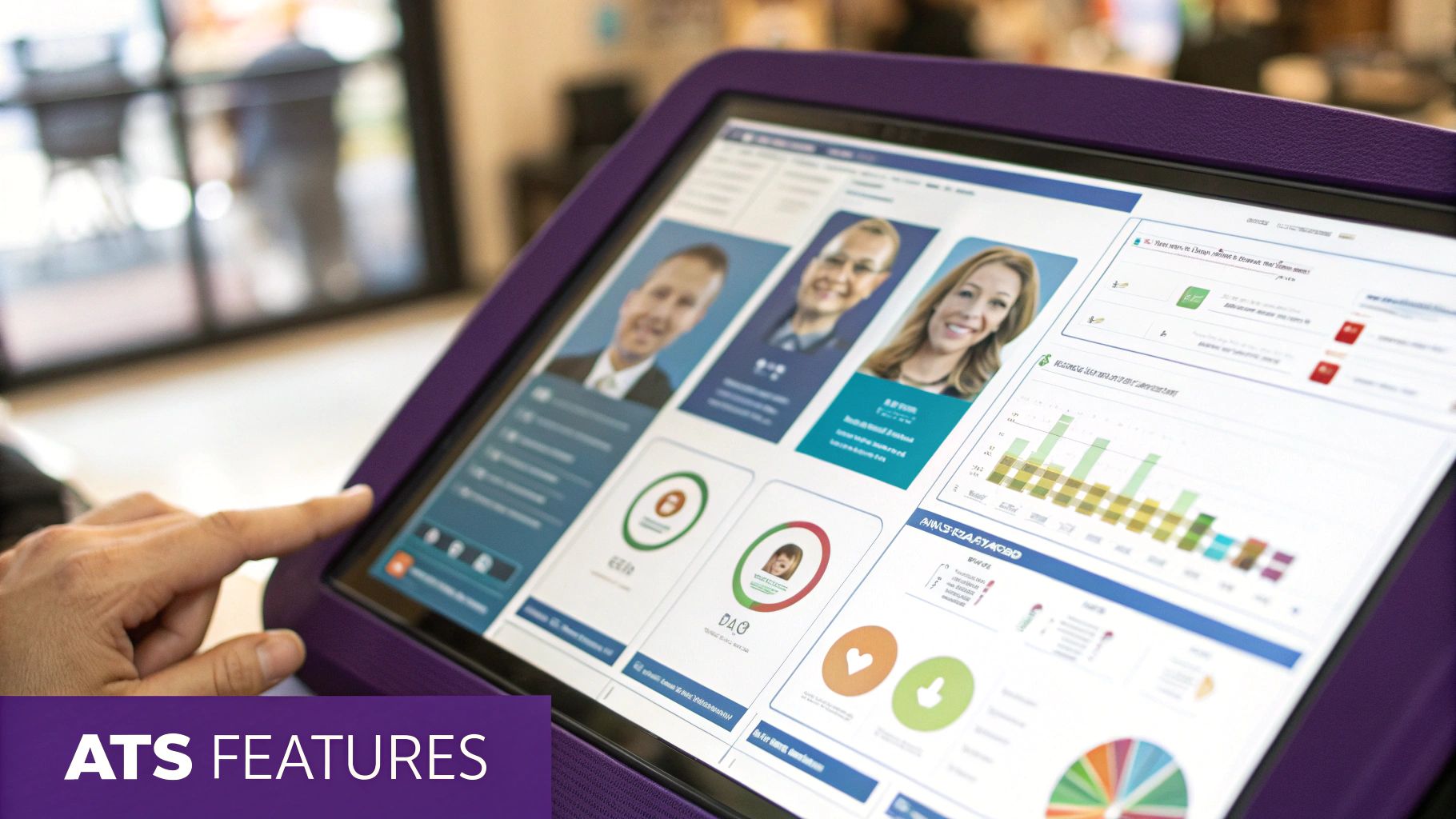
As a small business owner, you understand the value of every minute and every pound. Balancing sales, operations, and customer service can make hiring seem like an overwhelming chore. You post a job, and suddenly your inbox is overflowing. CVs get misplaced, great candidates never receive feedback, and you spend hours organising interviews instead of focusing on your business.
Does this sound familiar? This chaotic reality of manual hiring isn't just inefficient; it's a genuine barrier to growth. If you can't find the right people quickly, you can't expand. A small business applicant tracking system transforms this disorganised scramble into a proactive, professional recruitment process.
Consider a local bakery with a loyal customer base, ready to open a second location. The owner, already stretched thin, needs to hire a new team. Using email, she's quickly overwhelmed. Applications are buried among supplier invoices and customer queries. She accidentally deletes a promising CV and forgets to reply to three others, who promptly accept jobs elsewhere.
This story is all too familiar. The owner isn’t a poor manager; she's simply using the wrong tools for a crucial task. An ATS could have revolutionised her entire process almost overnight.
Reclaim Your Most Valuable Asset: Your Time
An ATS automates the most tedious, time-consuming aspects of hiring. Instead of manually posting your job on various sites, you do it with a single click. Instead of managing hundreds of emails, all applications are organised on one central dashboard. This isn't just a minor adjustment; it's a major shift in how you operate.
The time saved can be reinvested into your business. You can focus on interviewing top candidates, developing products, or training your current team. An ATS handles administrative tasks, allowing you to concentrate on the human elements of hiring.
Build a Professional Employer Brand
Your hiring process reflects your company. A messy, slow, or unresponsive approach sends a clear message to potential employees: your business is disorganised. Top candidates have many options, and they won't wait for a company that can't manage a simple application.
An ATS creates a smooth and professional candidate experience from the first interaction.
Instant Acknowledgement: Automated emails confirm receipt of applications, so candidates know they haven’t been ignored.
Clear Communication: Keep candidates informed at every stage, even if it’s just a polite rejection. This courtesy protects your reputation.
Faster Process: A streamlined workflow allows you to move candidates from application to offer quickly, securing top talent before competitors.
A positive candidate experience is a powerful recruitment tool. It builds goodwill and shows you value people’s time, making your company more appealing to work for.
This is increasingly important as more companies adopt ATSs. The applicant tracking system market is projected to grow from USD 71.17 million to over USD 118 million by 2033. This growth is driven by businesses recognising the need for better tools to attract quality talent in a competitive market.
Make Smarter Decisions with Data
Are your job ads on LinkedIn more effective than those on Indeed? Where do your best hires come from? When hiring manually, these questions are challenging to answer. You're left relying on intuition rather than concrete data.
A good small business applicant tracking system provides access to simple, powerful data. You can quickly see your time-to-hire, identify the most effective job boards, and evaluate your recruitment pipeline. This data enables smarter, more cost-effective decisions, ensuring your hiring budget is spent effectively.
Our guide explores many of the key benefits an ATS delivers for smarter hiring in more detail. By understanding these advantages, you can move from reactive to strategic hiring.
Must-Have Features in a Small Business ATS
Choosing an applicant tracking system for your small business can feel overwhelming. Let's be honest, not all platforms are created equal. Some are packed with complex, enterprise-level features that are unnecessary for a smaller company, while others are too basic to significantly reduce your workload.
To make the right decision, focus on core features that deliver real value. These aren't flashy add-ons; they're tools that transform your hiring from a chaotic process into an organised, efficient operation. Knowing what to look for helps you evaluate different systems and invest in one that addresses your hiring challenges without breaking the bank.
Centralised Job Posting
Imagine having a new vacancy. Now you must log into multiple job boards, each with its own interface, just to post the same role. It’s tedious and time-consuming.
This is where centralised job posting is invaluable. You write your job description once, and with a single click, the ATS publishes it across multiple job boards and social media platforms. It saves hours of admin for each role you advertise and expands your reach. For a small business competing with larger entities, getting your advert in front of the widest audience is crucial.
The infographic below highlights the core benefits an ATS brings to a business, linking these efficiency gains to better hiring outcomes.

As shown, it's a chain reaction. Greater efficiency attracts better candidates, leading to real cost savings.
Here's a quick look at essential ATS features and their value for small to medium-sized businesses.
Essential ATS Features and Their Value for SMEs
| Must-Have Feature | What It Does | Why It's Critical for a Small Business |
|---|---|---|
| Centralised Job Posting | Posts a single job advert to multiple platforms at once. | Saves countless hours of manual work and greatly increases job visibility. |
| Resume Parsing | Scans CVs to extract key data like contact info, skills. | Prevents email overload by building a searchable database for relevant candidates. |
| Customisable Pipeline | Creates a drag-and-drop workflow for hiring stages. | Offers a clear view of the entire hiring process, making it easy to track candidates. |
| Automated Communication | Sends pre-written emails automatically. | Ensures every candidate receives a professional response, maintaining your brand. |
| Reporting & Analytics | Tracks key hiring metrics. | Provides data to see what’s working, enabling smarter hiring decisions. |
These features aren't just optional; they're the backbone of effective recruitment for any growing business.
Resume Parsing and Candidate Database
When applications flood in, your email inbox can quickly become unmanageable. Sifting through numerous CVs attached to different emails is not only inefficient but a recipe for missing out on great candidates. This is where resume parsing is beneficial.
An efficient ATS will automatically scan incoming CVs, extract essential information such as contact details, skills, and work history, and create a neat, searchable profile for every applicant. Everything is stored in one central database.
Find Skills Instantly: Need someone with "project management" experience? Type it into the search bar to see every relevant applicant. No more manual searching.
Build a Talent Pool: A candidate might not fit this role but could be perfect for the next one. Their details are saved, allowing you to build a valuable talent pool for future openings.
Keep Records Organised: All candidate information, notes, and communications are stored in one place. Comparing applicants is straightforward when you aren't juggling countless files and email threads.
This organised database forms the foundation of an efficient hiring process. It's a key reason why the UK applicant tracking system market, valued at around £284 million, is expected to reach £469 million by 2029. This growth is driven by AI-powered features like parsing, which help businesses without large HR teams find the best candidates quickly. You can read the full research on the ATS market to understand these trends better.
Customisable Hiring Pipelines
Every business hires differently. The steps to hire a software developer differ significantly from those for a customer service agent. A rigid, one-size-fits-all process is inadequate.
That’s why a customisable hiring pipeline is essential. This feature allows you to create a visual workflow that mirrors your recruitment process. Think of it like a Trello board, where each candidate is a card you can drag and drop through stages such as:
Applied
Screening
Phone Interview
Technical Test
Final Interview
Offer
This visual approach provides a comprehensive view of your hiring landscape, letting you see exactly where every candidate is in the process.
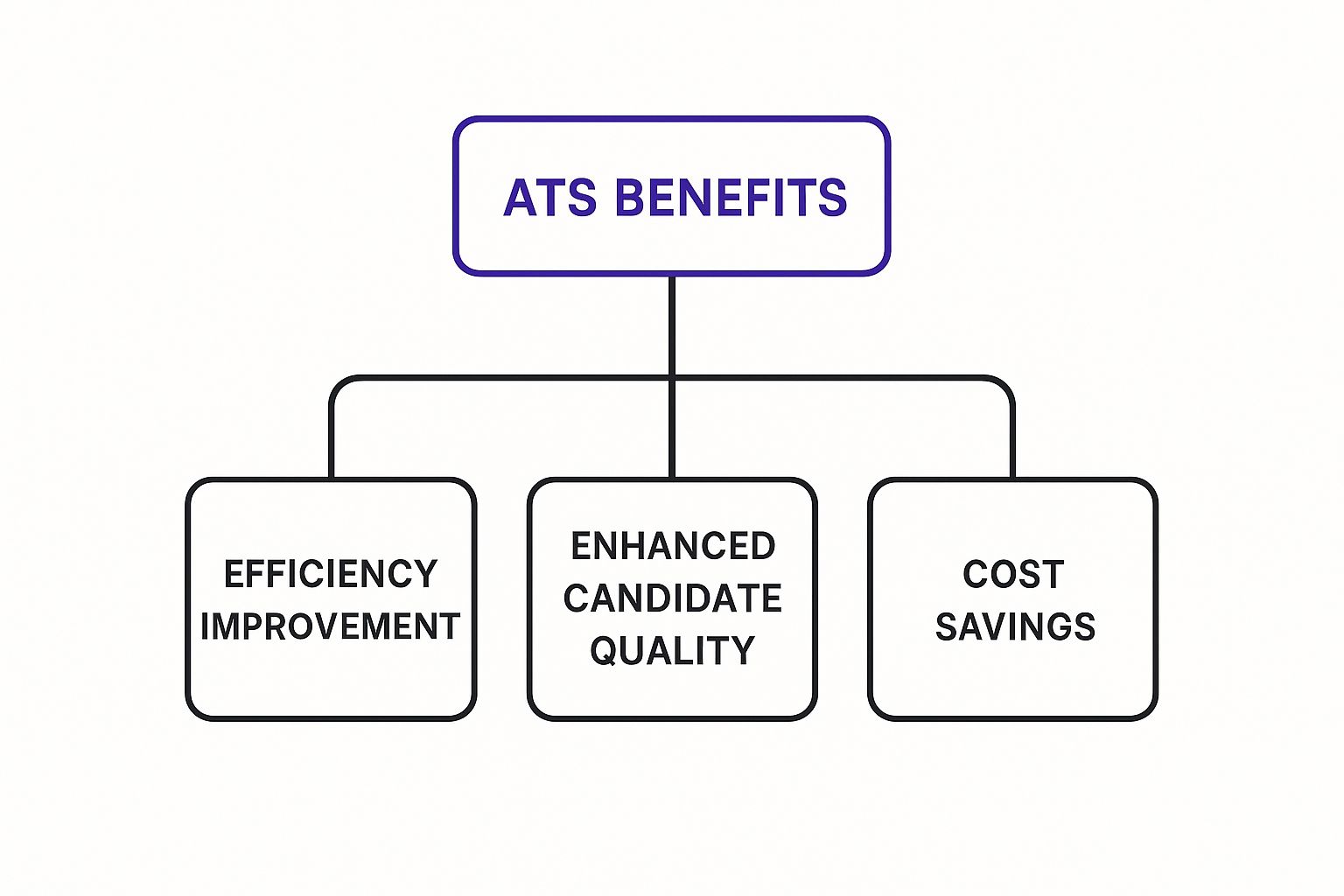
The screenshot above demonstrates the power of a clean, visual pipeline for tracking progress and spotting potential bottlenecks.
Automated and Centralised Communication
One of the quickest ways to damage your employer brand is to leave candidates in the dark. Being ignored by a potential employer feels unprofessional and can deter great applicants. An ATS addresses this with automated communication tools.
Set up email templates to automatically send acknowledgements when someone applies or to inform unsuccessful candidates that the position has been filled. This ensures every applicant receives a timely, professional response.
This automation frees you from the tedium of writing repetitive emails, giving you time to focus on meaningful conversations with top contenders. All communication is logged against the candidate's profile, creating a complete, organised history of every interaction. This is vital for maintaining positive relationships and learning how to create an outstanding candidate experience.
How to Choose the Right ATS for Your Business
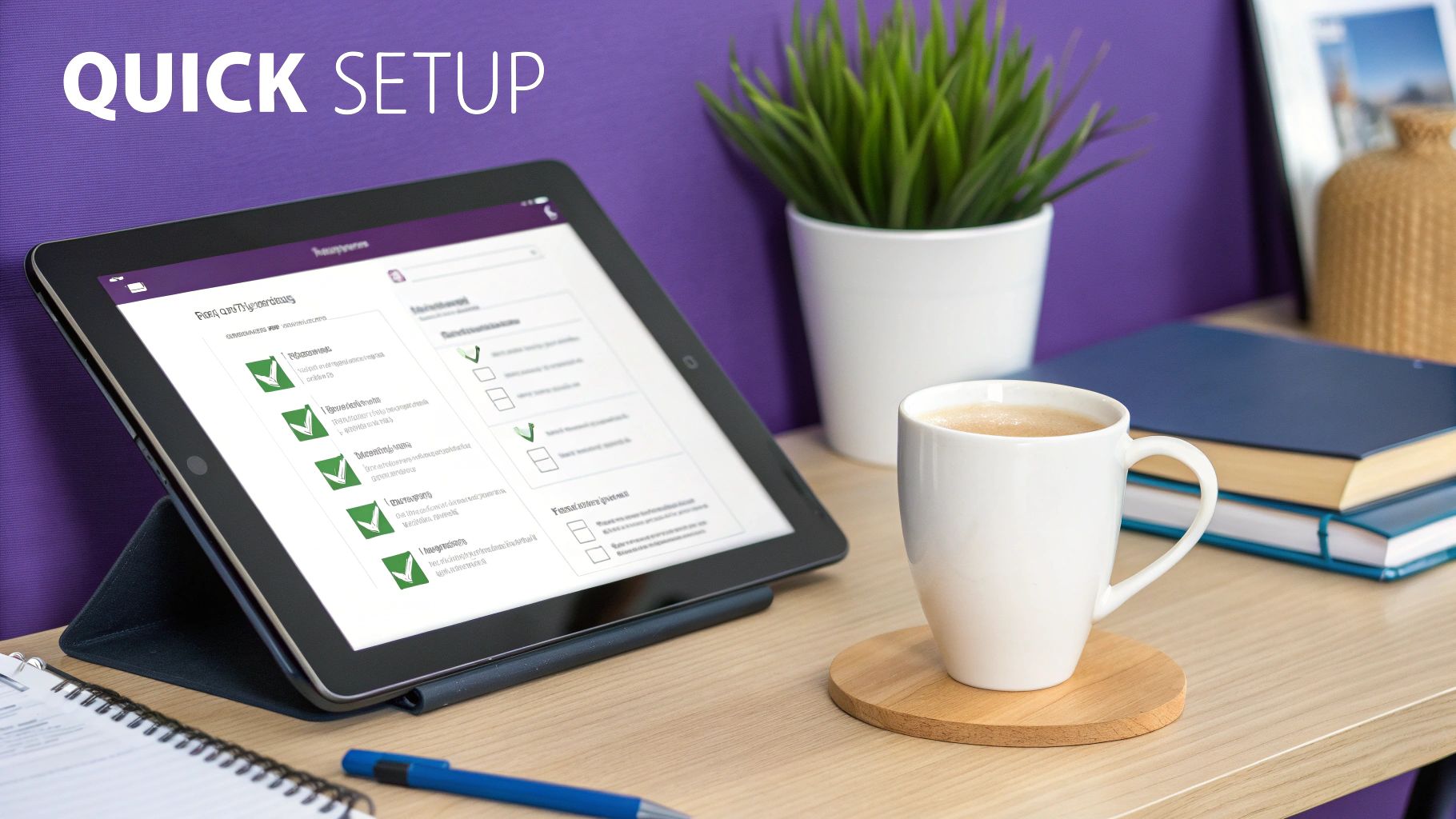
Choosing the right software for your business always feels like a crucial decision, and selecting a small business applicant tracking system is no exception. With numerous options available, it’s easy to become overwhelmed by feature lists and complex pricing models. The key is to focus on what your business actually needs to improve hiring.
This isn’t about finding the most powerful system on the market. It’s about finding one that fits your team seamlessly. The right choice will integrate naturally into your workflow, while the wrong one will become a cumbersome, expensive burden. By taking a step-by-step approach, you can confidently select a platform that saves time, enhances hiring, and grows with your business.
Assess Your Specific Hiring Needs
Before reviewing any options, evaluate your current hiring process. Where are the real challenges? Are you spending hours posting jobs individually? Are great CVs getting lost in your inbox? Is slow communication with candidates hurting your reputation? Be honest about your challenges – that’s the starting point.
Then, create a simple list of must-haves versus nice-to-haves.
Must-Haves: Non-negotiable features essential to solving your biggest problems, like one-click job posting, a searchable candidate database, or basic reporting.
Nice-to-Haves: Features that would be beneficial but aren't crucial, such as integrated video interviewing or advanced analytics.
This exercise acts as a powerful filter, helping you quickly dismiss systems that don't meet your core needs and preventing distraction by flashy features you’ll likely never use.
Set a Realistic Budget
For any small business, cost is always a major factor. Applicant tracking systems come in various forms, from free basic plans to expensive enterprise subscriptions. Consider the total cost of ownership, not just the monthly fee.
Watch out for hidden fees. Some providers charge extra for additional users, job postings, or essential integrations. Look for a provider with transparent, scalable pricing that allows you to start small and upgrade as you grow.
Remember to view this as an investment, not just another expense. If an ATS saves your team 10 hours a week on admin, what’s that time really worth? A system that helps you make just one better hire a year can deliver a return that exceeds its annual cost.
Evaluate Key Vendor Attributes
Once you have a shortlist of platforms that fit your needs and budget, dig deeper. The software is only part of the equation; the company behind it is equally important. For a detailed look at the basics, check out our guide on what an applicant tracking system is and if you need one-and-do-you-need-one/).
When comparing vendors, focus on these critical areas:
Ease of Use: Is the interface intuitive? A small business applicant tracking system should be designed for people who aren't full-time HR professionals. If extensive training is required, it’s adding work, not reducing it.
Scalability: Can the system grow with you? Your hiring might be simple today, but you need a platform that can handle more complexity as you expand.
Integrations: Does it integrate seamlessly with your existing tools? Integration with your email, calendar, and preferred job boards is essential for a smooth workflow.
Customer Support: What support is available when you need help? Look for vendors known for responsive, helpful support. Read reviews to see how they handle issues.
The best way to assess these factors is to experience free trials and live demos. Never commit without seeing the system in action. Use the trial period to post a real job, move test candidates through the process, and get a genuine feel for the software. This is the most reliable way to ensure a smart investment.
Getting Your New ATS Up and Running for Maximum Impact
Selecting your small business applicant tracking system is a significant step, but the real impact happens during setup. Think of it like purchasing a high-quality oven; it has the potential to help create incredible meals, but only if installed correctly and used effectively. A smooth rollout ensures you get value from your investment immediately, turning new software into a hiring powerhouse from day one.
The process doesn't need to be overwhelming. By focusing on a few key steps, even a busy small business owner can implement their ATS efficiently, avoiding common delays. The aim is to transition from purchase to productivity swiftly.
This involves customising your hiring pipeline. Define the stages a candidate moves through at your company—from "New Applicant" and "Initial Screening" to "Final Interview" and "Offer Extended." When the pipeline mirrors your reality, the system becomes second nature for everyone using it.
Get Your Team On Board
Even if your "hiring team" is small, training and communication are essential. A new system is only effective if used consistently. Don't assume everyone will figure it out independently.
Schedule a session to walk them through the new platform. Focus on core tasks like reviewing candidates, leaving feedback, and moving candidates through the pipeline. Keep it simple and emphasise the "why"—explaining how the tool makes their lives easier and helps the business find better people, faster.
To ensure a successful launch, follow this simple plan:
Announce the Change: Inform your team about the new system and its benefits. Present it as a positive step to eliminate administrative headaches.
Provide Hands-On Training: Conduct a live demo using a test job. Let team members practice adding notes and changing a candidate's status.
Create a Simple Cheat Sheet: A one-page guide with screenshots of key functions can be invaluable during the first few weeks.
Lead by Example: Be the system's biggest advocate. Consistently use the ATS for hiring-related conversations and decisions, encouraging others to follow suit.
Implementing the system correctly transforms your new small business applicant tracking system into a central part of your growth strategy. It organises your past, present, and future talent, providing an efficient, professional process that offers a competitive advantage.
Why SeeMeHired Is the Ideal UK Small Business ATS
Identifying what makes a great applicant tracking system is one thing. Finding one that perfectly suits a UK-based small business is another challenge entirely.
This is where SeeMeHired excels. It's not just another ATS off the shelf; it’s a system built with the unique challenges and opportunities of UK SMEs in mind. It directly addresses the core problems that can hinder growth, like cumbersome software and administrative burdens.
Instead of a complex interface that takes weeks to master, its design is clean and intuitive. Your team can start and see results almost immediately, no dedicated IT department needed.
Built for UK Business Realities
Many generic systems overlook the nuances of the UK market. SeeMeHired is different. It includes tools to manage GDPR compliance—a critical task for any business handling candidate data. This focus provides peace of mind and significantly reduces administrative risk.
Additionally, its one-click job posting feature connects to job boards relevant to UK employers. You can publish vacancies to major national and specialist industry boards instantly, ensuring your role is seen by the right local talent pool.
This screenshot shows the clean, organised dashboard that greets you in SeeMeHired.
The layout provides clarity and control, presenting key hiring information without feeling cluttered.
Affordable and Scalable for Growth
For many small businesses, cost is a major barrier. Enterprise-level systems often come with prohibitive price tags and rigid, long-term contracts. SeeMeHired breaks the mould with flexible and affordable pricing plans designed to scale with you.
You can start with a plan that fits your current needs and budget, then upgrade seamlessly as your company grows and your hiring demands increase. This model reduces financial risk and makes powerful recruitment technology accessible.
SeeMeHired provides a practical solution by focusing on impactful features:
Effortless Job Posting: Send your ads to multiple boards at once, saving hours of tedious work.
Visual Hiring Pipeline: Track each candidate’s progress with a simple drag-and-drop interface.
Automated Communication: Maintain a professional brand by ensuring no applicant is left in the dark.
Centralised Candidate Data: Build a searchable talent pool for current and future roles.
By combining an intuitive interface, essential UK-specific features, and scalable pricing, SeeMeHired stands out as the logical choice for any small business looking to professionalise its recruitment. It’s the ideal small business applicant tracking system because it equips you to compete for top talent, reclaim valuable time, and build the team that will drive your future success.
Frequently Asked Questions About Small Business ATS
Introducing new technology into your business often raises questions. It’s entirely normal. To help you feel confident in your decision, we’ve addressed common queries from small business owners about applicant tracking systems.
Is an Applicant Tracking System Too Expensive for a Small Business?
This is a common misconception, but the reality has changed significantly. While these platforms were once exclusive to large corporations, there are now many affordable options tailored for small businesses. Providers like SeeMeHired offer tiered pricing, often with free or low-cost starter plans to get you started without a large investment.
The real question isn't just about cost, but about return. Consider the hours saved on admin and the value of making a better hire. The system often pays for itself quickly. The key is to choose providers with clear, flexible pricing and no long-term contracts.
Will an ATS Make My Hiring Process Too Impersonal?
It's a valid concern. Nobody wants to become a faceless corporate entity. However, a good ATS should do the opposite. By handling repetitive, impersonal tasks—like sending acknowledgement emails or standard rejection notes—it frees up your time.
This enables you to focus on the human aspect of recruiting, where it truly matters. You can dedicate more time to conducting thoughtful interviews, building genuine relationships with top candidates, and understanding who they are. An ATS manages logistics so you can focus on personal interactions.
How Can an ATS Support Fair Hiring Practices?
A well-configured system is a powerful tool for promoting fairness and equity. By standardising the application and initial screening process, an ATS ensures every candidate is evaluated consistently. This step significantly reduces unconscious bias.
It also creates a transparent, documented trail of all hiring decisions, bringing much-needed accountability to the process. To explore further, check out our guide on 8 best practices for diversity recruiting. An ATS provides the structure needed to implement these crucial principles.
How Hard Is It to Set Up and Learn a New ATS?
Modern applicant tracking systems designed for small businesses are all about simplicity. Most are cloud-based and feature intuitive interfaces that don't require extensive technical knowledge. A quality provider will offer straightforward setup, clear guidance, and responsive customer support.
These platforms are often designed for business owners and managers, not just HR professionals. The goal is to get you organised and posting your first job in under an hour. Always take advantage of a free trial to experience the software firsthand and assess its suitability.
Ready to see how an ATS could improve your hiring process? SeeMeHired offers an intuitive, all-in-one platform designed specifically for UK businesses. Start your free trial today and discover a more efficient way to build your team.

